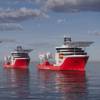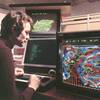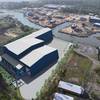Among the world’s great commuter boats, the fleet of the Chao Phraya Express Boat Company holds a particular place. Not only for its singular success in moving large numbers of passengers in a city whose roads are notorious for their traffic jams, but also for the beauty of the fleet of graceful wooden boats. Thai culture recognizes four great principles; Suay (beautiful), saad (clean), sanook (fun), suparp (appropriate). These boats meet all four criteria. Their beautifully clean lines speak for themselves but they are also entirely appropriate to their function and, as any Bangkok tourist will confirm, they are great fun to ride.
The Chao Phraya River winds through the homes, temples and businesses of the approximately eight million people of Bangkok. The ferries of the Express Boat Company take commuters and shoppers along the 18 kilometers of river flowing through the city. The service operates between 6:00 AM to 8:00 PM. While some red-flagged boats stop at only half of the piers and other yellow-flagged boats at only eight piers, the standard boats call at all 34 of the city maintained piers. At each of those stops they must load and unload up to 60 people in one minute, if they are to maintain their schedule.
Founded over 70 years ago, by current owner and president Khun Supapan’s Grandmother, the company now includes amongst its fleet of boats, over 60 of the twin and single-engined commuter ferries. With each ferry making four trips up and down the river per day, the company’s 200 trips carry a weekday total of 40,000 passengers or well over 10 million per year. This is all done on a stretch of river that has a dozen ferries diagonally crossing the path of the commuter boats and a steady stream of tugs with huge barge tows and a cacophony of other maritime traffic. The river currents, which surge up and down with the tides from the Gulf of Thai
land, are in constant turmoil from the conflicting vessel wakes. Altogether enough traffic and confusion to make the most chaotic novice sailing race look like a disciplined marching band.
The backbone of the current fleet is composed of about 50 single-propeller boats. With a beam of only 2.7 meters and a dramatic forward rake pointing needle sharp ahead of the captain at his helm, itself set well forward and mid ship, these wooden boats are as dramatic in appearance as the most rakish modern catamaran. Their length varies from 26 to 32 meters depending on the wood available at the time of building. On a river whose width seldom exceeds two hundred and fifty meters, these boats don’t require any navigational aides. Most of the single engine boats retain the chain and cable system connecting the helm to the single 53-cm square rudder. Clutch control to the ZF 1RM gears with 2:1 reduction on aft-mounted 350 HP NT855 Cummins diesels has also been mechanical. Although the new builds and rebuilds are being upgraded to hydraulic controls.
Khun Supapan explains that unlike buses, the ferry schedule is not restricted by traffic. “They can be counted on to arrive at a dock precisely at a given time,” she says, adding with a warm smile, “If they don’t I will make a phone call and see that they do.”
That these are wooden boats in an age of aluminum and fiberglass is not insignificant. Thai teak has long been known for its longevity and strength. Unfortunately, over-cutting has required the Thai and other Southeast Asian governments to protect the few remaining teak forests. When an Express Boat requires one of its one-inch thick planks or a sawn frame to be replaced, the best the company’s repair yards can do is to replace it with Golden Takien imported from Lao and Cambodia as logs and sawn in local mills. But the quality of workmanship that built these boats continues in the company yards.
In recent years a number of twin engine boats with five-meter beams allowing larger passenger capacities of up to 150 or more people have been built for the fleet at company yards in Bangkok and Ayuthaya. While the company has considered steel hulled and even marine plywood for their replacement boats, they continued to build plank on frame style boats although golden takien rather than teak is used through out. With their 1x12-inch planking fastened with stainless steel screws and through bolted to the longitudinals the boats have great strength. To survive numerous landings on steel piers in turbulent waters, wood construction of the ferries is protected by four-inch pipe guards mounted on 2-by-4-inch timbered guards.
In November this year, a new single screw hull was taking shape in the company’s Aythya shipyard under the direction of master shipwright Khun Payung Thanichet. Outside a twin screw boat was getting an extensive overhaul with numerous new planks and guards. Alongside the pier a newly built twin screw boat floated gracefully on the brown waters. Its brightly painted waterline strip gracefully separating the white hull from the brown waters. A recent innovation had seen the pilot house moved to the top of the passenger accommodation area for improved visibility and increased passenger capacity.
While the wood work on the new boat was all new, the Cummins 855 engines were drawn from the 80 odd engines of the same make and model that the company owns. The choice of Cummins has evolved from a combination of availability and reliability. Thailand’s Cummins distributor, Diethelm & Company Ltd. handles the rebuilds and the engines just keep on keeping on. From an engineering perspective, these engines when matched with these elegant wooden hulls meet the four Thai principles of Suay (beautiful), saad (clean), sanook (fun), suparp (appropriate).
Sponsored Content
Maritime leaders unite to tackle ocean plastic with launch of new alliance: the Maritime Association for Clean Seas

ABS Wavesight Advantage™: One Intelligent, Connected Maritime Platform to Transform Complexity into Operational Clarity

Subscribe for
Maritime Reporter E-News
Maritime Reporter E-News is the maritime industry's largest circulation and most authoritative ENews Service, delivered to your Email five times per week









